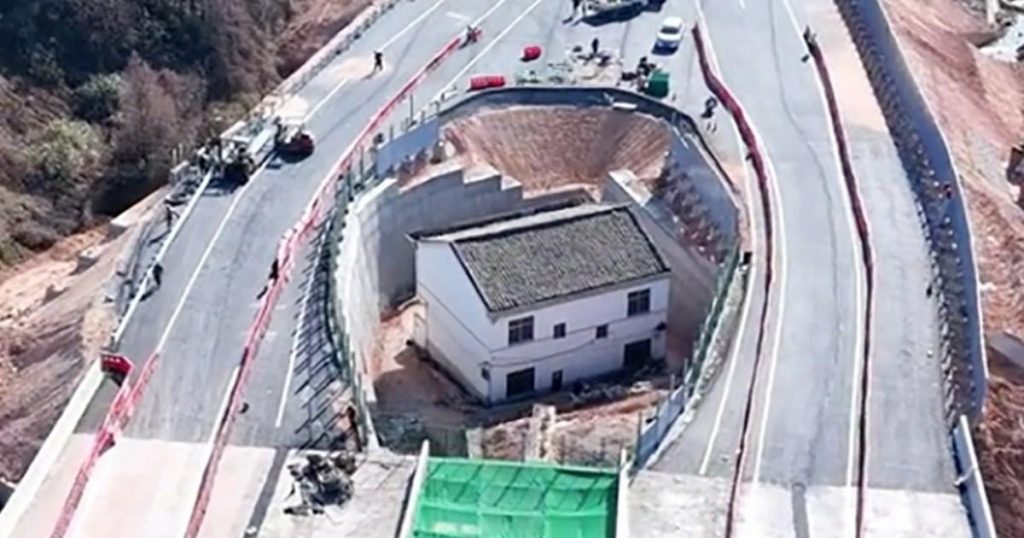The Tale of Huang Ping’s House: A Standoff Against Progress in China
In the bustling landscape of modern China, where urbanization rapidly transforms ancient villages and farmlands into sprawling metropolises, stories of resistance against the relentless tide of development often emerge. One such story is that of Huang Ping, a grandfather whose stubborn refusal to leave his ancestral home has resulted in a peculiar and poignant standoff against progress. His two-story house now stands as a solitary island amid a newly constructed motorway in Jinxi, a town southwest of Shanghai, a stark reminder of the human cost of development and the complexities of individual rights in the face of collective advancement.
Huang Ping’s predicament began with the government’s initiative to build a motorway through his village. Like many others, he was offered a compensation package to relocate, a common practice in China’s rapid development projects. However, Mr. Ping deemed the offer insufficient and refused to budge, clinging to his home and the memories it held. As the construction progressed, his neighbors accepted the government’s terms and moved, leaving Mr. Ping and his 11-year-old grandson as the sole inhabitants of a rapidly shrinking island of the past. The construction crews, unable to demolish the house due to Mr. Ping’s unwavering stance, were forced to build the motorway around it, effectively creating a bypass that encapsulates his home within its concrete embrace.
The once-peaceful village has now transformed into a noisy construction site, forcing Mr. Ping and his grandson to seek refuge in the town center during the day, returning to their isolated home only in the evenings when the work ceases. The temporary respite, however, offers little solace, as Mr. Ping now faces the grim reality of living permanently in the middle of a busy motorway, a constant reminder of his decision and the potential consequences he hadn’t fully foreseen. The anticipated noise and pollution from the constant flow of traffic once the road opens in the spring weigh heavily on his mind, prompting regret and a sense of having made a costly miscalculation. He admits that if he could turn back time, he would have accepted the compensation offer, a stark admission of the toll this prolonged standoff has taken on him.
While Mr. Ping grapples with his decision, his story has captured the public’s imagination, turning his house into an unlikely tourist attraction. Locals and visitors alike flock to the site, snapping pictures and marveling at the unusual sight of a house stubbornly clinging to its ground amidst a sea of asphalt. Mr. Ping has been dubbed the "strongest nail house owner" in China, a term used to describe individuals who refuse to vacate their properties for development projects, their homes standing like stubborn nails refusing to be hammered down. These "nail houses" are often seen as symbols of resistance against perceived unfair compensation practices or a desire to preserve one’s home and history in the face of relentless modernization.
The term "nail house" itself speaks volumes about the context of rapid development in China, where the needs of the many often supersede the rights of the few. The image of a single nail stubbornly protruding from a smooth surface encapsulates the struggle between individual property rights and the collective drive towards progress. The phenomenon of nail houses highlights the complex interplay between individual and collective interests, raising questions about fair compensation, the preservation of cultural heritage, and the human cost of development. While Mr. Ping’s case is unique in its physical manifestation, it represents a broader struggle playing out across China as individuals grapple with the rapid transformation of their communities.
The details of the compensation offered to Mr. Ping reveal the intricate dynamics of these negotiations. He was initially offered £178,245 (CNY 1.6 million) and two other properties, a sum that was later increased to include three properties. However, Mr. Ping remained dissatisfied with the offer, leading to the current impasse. The reasons for his dissatisfaction are not fully clear, possibly stemming from a perceived undervaluation of his property, emotional attachment to his ancestral home, or a principled stand against what he might view as insufficient compensation. Whatever his reasons, the outcome is a stark reminder of the power imbalances often present in such negotiations. The government, with its vast resources and mandate for development, often holds a stronger bargaining position compared to individual homeowners.
Mr. Ping’s story is far from unique in China, where the rapid pace of development often leads to disputes between residents and authorities over land acquisition and compensation. Similar cases have been reported in the past, including the 2015 story of a nail house in Channing that remained standing in the middle of a massive housing development for a decade. These stories highlight the ongoing tension between progress and preservation, individual rights and collective needs. While the government emphasizes the importance of development for economic growth and improved living standards, the experiences of individuals like Mr. Ping underscore the need for greater transparency, fairer compensation practices, and a more nuanced approach to development that takes into account the human cost of progress. As China continues its rapid modernization, the question of how to balance development with individual rights remains a crucial challenge, and the tale of Huang Ping’s house serves as a potent symbol of this ongoing struggle.











